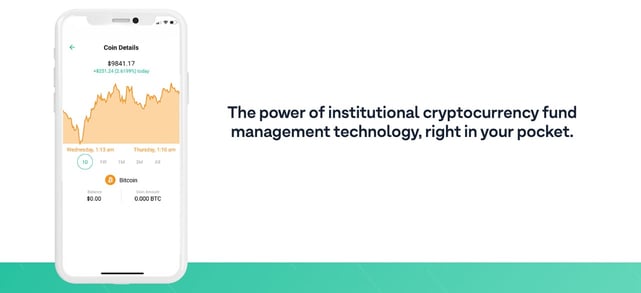In a Nutshell: When Alex Wang and his friends learned that they couldn’t invest in cryptocurrency hedge funds because they lacked assets, the group created a solution to change that. The mobile-only Ember Fund platform leverages the efficiencies of crypto smart contracts to make institutional hedge fund access available to a global audience. Ember Fund combines the features of a mainstream crypto exchange with machine-powered fund management to build a bridge to the financial ecosystem of the future.
Alex Wang developed an interest in cryptocurrency while working as a product manager at an artificial intelligence company in 2016. But when he visited a popular crypto exchange with thoughts of investing, he couldn’t find a path forward. The crypto world turned out to be a maze of thousands of competing currencies, all seemingly with volatility issues, and new coins and platforms popping in and out of existence.
“What I found is that crypto is not digestible to the normal consumer, in the sense of understanding and following the technology,” Wang said.
So, he decided to find an expert to help him. But he encountered plenty of obstacles there, too.
“I wanted to invest alongside people who knew what they were doing — a quant manager or something — and found it impossible, from a legal perspective,” he said. “Hedge funds often require you to be high net worth just to participate.”
Wang said he thought that was counterintuitive given that crypto was supposed to democratize financial products.
At his company, Wang worked with a close-knit group of like-minded individuals, and they discussed how to build the kind of product that would solve that problem.
The result was the Ember Fund, the first mobile-only platform that allows users anywhere in the world to buy into managed crypto funds without holding their assets.
“It was a perfect team to assemble because we were all passionate about crypto,” Wang said. “And all the existing solutions were just wallets — they didn’t help educate us on what to buy, when to sell, and why.”
They worked quickly to develop Ember Fund and get it to market, where it immediately filled a glaring void in the crypto industry.
“In February 2018, we sat down over a weekend and built a prototype,” Wang said. “Six months later, we were ready to quit our jobs. And the rest is history.”
Products for a Wide Range of Investment Strategies
In early 2020, Ember Fund ended its bootstrapping era, closing out a round of Reg CF crowdfunding with additional angel/VC support and emerging products and users. So far, the platform has processed more than 100,000 transactions worth more than $10 million for 20,000-plus investors.
Ember Fund brings one-tap investing to mobile users with as little as a few hundred dollars and an internet connection. It accomplishes that by partnering with top cryptocurrency veterans to construct and curate its funds. It also supports Bitcoin, along with other widely used altcoins, on its exchange.
Cutting-edge wallet technology enables investors to hold their own assets instead of relying on the platform or a third party and exposing themselves to potential compromise. Meanwhile, transactions occur transparently on the blockchain, with Ember Fund consulting multiple exchanges to find the best rates.
Ember Fund allows anyone to invest in cryptocurrency funds from anywhere.
Portfolios range from high-risk/high-return products to more conservative options. The Marius S-Tier Fund, for example, the platform’s inaugural offering, is designed for aggressive investors looking to capitalize on altcoin volatilities.
“It’s between three and five altcoins that our fund manager picks and rebalances,” Wang said. “It’s been up 300% to 400% at times, but when the market pulls back, it also pulls back quite a bit.”
The platform’s newest flagship product is the Quant Fund, which rebalances Bitcoin against the dollar-backed USDC stablecoin. The Quant Fund arose out of a partnership with crypto hedge fund Blockforce Capital. It functions like a hedge fund with the goal to capture the majority of Bitcoin’s upside but only a fraction of its downside.
“That’s been highly successful. A lot of people are excited about it, and we’re starting to ramp up on that,” Wang said.
Tech Helps Securely Optimize Risks and Returns
Additional products are also in progress, including a lending product leveraging USDC that is built on the Compound platform’s algorithmic, autonomous interest rate protocol. It programmatically pays investors between 1% and 8% APR on their money, with the novelty that the interest is paid every 15 seconds.
“The big advantage is that it allows you to have a lot of flexibility — you could put in $10 and then collect interest for a couple of minutes and then pull it back out,” Wang said.
Alex Wang, CEO and Co-Founder of Ember Fund
The protocol programmatically sets the interest rate based on lending and borrowing demand, pooling funds into one blockchain smart contract.
“That opens us up to the whole world of decentralized finance, where everything is locked into code, and it allows you to deposit and redeem instantaneously,” Wang said. “There are so many interesting things that will come from using that tech instead of a traditional lending platform.”
Because there are no intermediaries in those transactions, interest rates can be astronomically higher, according to Wang.
Meanwhile, Blockforce Capital brings precise artificial intelligence and machine learning to Ember Fund.
“Their team of data scientists is crunching a ton of on-chain data and extrapolating different models,” Wang said. “We work with them to choose and tweak the models accordingly.”
And as a mobile-only, non-custodial platform, all user transactions are transparent, but private keys and other sensitive data remains opaque to Ember Fund. No one associated with the platform or approaching it from outside can see what’s going on.
“The private keys that are essentially passwords to your crypto are encrypted and stored on your device,” Wang said. “That’s a core feature of our product, and one that we believe is the best way to store crypto securely.”
Democratizing Access to High-End Financial Services
Security is another reason why a global base of non-professional investors see Ember Fund as a path to liquidity. And its straightforward and transparent fee structure adds to that perception.
“Right now, we make money strictly on transactions,” Wang said. “When we route trades and rebalance funds, we search multiple exchanges for the best price, and we route the traffic — without touching the funds — to the best exchange. And the exchange simply pays us a fee for routing that traffic.”
Although the platform may add fees to its lending products in the future, the massive efficiencies intermediary-free blockchain technology brings to financial transactions through Ember Fund will be well worth it.
“Our bigger vision is to build a next-generation banking platform — one that’s a lot more transparent and that brings a lot more value to users,” Wang said. “Look at the wire fees and the late payment fees and then the low interest the legacy banks are paying on savings. The reason why that’s the case is banks have tellers, and they have these massive infrastructures.”
Ember Fund operates in an environment that leverages crypto to dispense with all of that. What that means for unbanked and underbanked individuals all over the world, only time will tell. But the implications are clear.
“Now, anyone in a developing country with a smartphone can download our app and effectively have a hedge fund and a Swiss bank account in their pocket,” Wang said.
Advertiser Disclosure
CardRates.com is a free online resource that offers valuable content and comparison services to users. To keep this resource 100% free, we receive compensation for referrals for many of the offers listed on the site. Along with key review factors, this compensation may impact how and where products appear across CardRates.com (including, for example, the order in which they appear). CardRates.com does not include the entire universe of available offers. Editorial opinions expressed on the site are strictly our own and are not provided, endorsed, or approved by advertisers.





![9 Best Credit Cards For Wealth Management ([updated_month_year]) 9 Best Credit Cards For Wealth Management ([updated_month_year])](https://www.cardrates.com/images/uploads/2021/08/Best-Credit-Cards-For-Wealth-Management.jpg?width=158&height=120&fit=crop)

![Global Entry vs. TSA PreCheck vs. CLEAR: Credit Card Benefit Comparison ([updated_month_year]) Global Entry vs. TSA PreCheck vs. CLEAR: Credit Card Benefit Comparison ([updated_month_year])](https://www.cardrates.com/images/uploads/2023/02/Global-Entry-vs.-TSA-PreCheck-vs.-Clear.jpg?width=158&height=120&fit=crop)